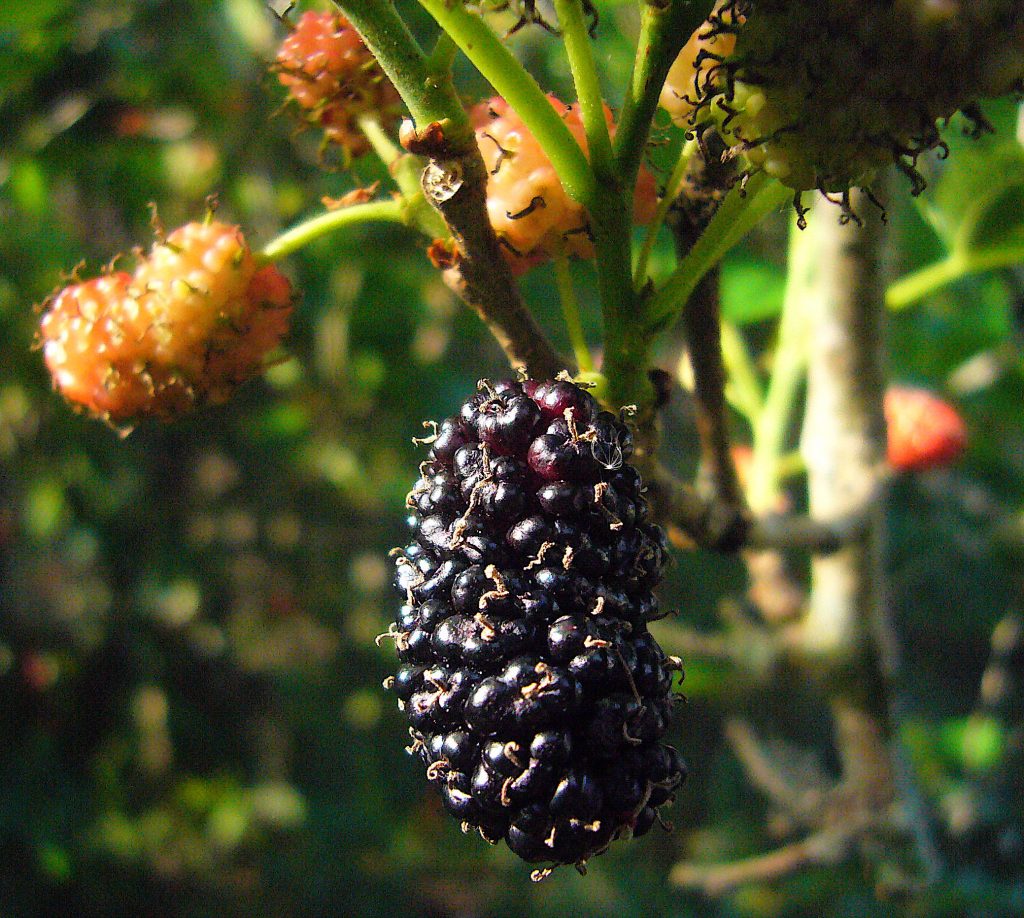
Mulberries resemble over-grown blackberries. Photo by Green Deane
Which tree has more life, the Mulberry or the Moringa? The latter will easily grow ten feet a year. But the mulberry refuses to die and they are starting to ripen now. One year I trimmed my Red Mulberry tree and used the stripped five-foot branches to prop up drooping branches on my nectarine tree. Undeterred the propping Mulberry branches took root and sprouted. So I potted them and gave them away. One still lives in a nearby town. As for the Moringa, it reseeded itself and I eventually had to coppice them to keep them in check. One odd thing about Moringa wood is that it is very fragile. You can easily break large branches by hand. My point is if you want a mulberry tree find a fruiting one and break off a branch now and stick it in the ground. It will grow.
Mulberries set fruit quickly and have a short season. From green to gone can be as short as six weeks. The fruit look like a long blackberry but sweeter (if ripe.) I know someone who tried eating young green fruit and raw leaves and said they had a mild mild-altering effect but also upset the stomach. Young leaves, however, can be cooked and eaten without mind or gastric upset. There are various species and cultivars of mulberries and they all have edible ripe fruit. However, general opinions agree that the darker the fruit when ripe the better it tastes. In many areas there are “white” mulberries which really have pink fruit. They were wildly planted to provide basic material for the silk industry (silk worms eat mulberry leaves.) Cooked silk worms are edible but do not have a pleasing taste. You can read more about Mulberries here.
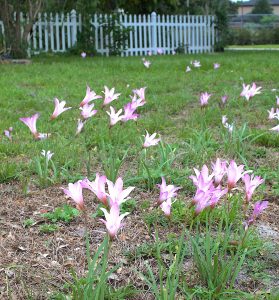
The Toxic Atamasco Lily. They can have all white blossoms as well. Photo by Green Deane
What are they? The first answer is they are NOT edible. The second is they are a threatened species. And the third answer is the toxic Atamasco lily, or Zephranthes atamasca which we saw in Largo this Saturday past. For a threatened species they are seen in a lot of lawns this time of year prompting many emails asking for an identification. These natives like wetlands but a well-watered lawn after seasonal rains will do nicely. The problem with the Atamasco/Rain Lily is that it resembles wild garlic before it blossoms (and even has a bulb!) However, it does not have the telltale garlic aroma. Remember if it smells like a garlic and looks like a garlic you can use it like a garlic. The Atamasco does not have any garlic aroma. It is not edible. All parts are poisonous. And while these in the picture have a pink tinge there are also all-white blossoms.

Foraging classes are held rain, shine, hot or cold. Photo by Nermina Krenata
As far as plants are concerned winter is over and green is busting out all over. Saturday we return to Florida State College in Jacksonville, Sunday’s class is nearly 300 miles southwest in Port Charlotte along the Peace River.
Saturday, April 3rd, Florida State College, south campus, 11901 Beach Blvd., Jacksonville, 32246. 9 a.m. to noon. We meet at Building A next to the administration parking lot. Whether the bathrooms are open or not is always a problem at this location.
Sunday, April 4th, Bayshore Park, Bayshore Drive. Port Charlotte. As a holiday has dropped the attendance to zero this class is cancelled and will be rescheduled. .
Saturday, April 1oth, Red Bug Slough Preserve, 5200 Beneva Road, Sarasota, FL, 34233. 9 a.m. to noon.
Sunday, April 11th, Spruce Creek Park, 6250 Ridgewood Ave. Port Orange, 32127. 9 a.m. to noon.
Saturday, April 17th, Jervey Gantt Recreation Complex, 2390 SE 36th Ave., Ocala, FL. 9 a.m. to noon. There is no fee for this class. You can make a donation afterwards if you like. This is because the City of Ocala says I must meet all the requirements of a football team if I want to teach in the park and charge a fee. It is either hold a free class there or never teach in Ocala.
Sunday, April 18th, Dreher Park, 1200 Southern Blvd., West Palm Beach, 9 a.m. to noon.
For more information, to sign up or prepay, go here.
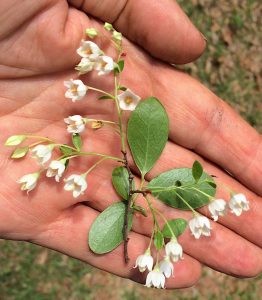
Sparkleberries are in blossom. Photo by Green Deane
April is a transition month. Many of winter edibles are ending their season and some of the spring and summer plants are starting. There is overlap and that can vary depending which end of the state you are on. The blueberries, also mentioned recenty, were impressive. I think they were Vaccinium arboreum, also called Sparkleberry and Farkleberry (and mistakenly Tree Huckleberry because they are not huckleberries.) We saw individual trees and a small hurst of them. V. arboreum is the only blueberry locally that gets to tree size. It has a flaking outer bark that reveals a reddish brown smooth inner bark. We also saw two Deerberry bushes, Vaccinium staminuem. That species is easy to identify because the blossoms have long stamens and the underside of the leaf is white. You can read about blueberries here. Incidentally, blueberries can have any number of seeds in them. Huckleberries, however, always have exactly 10 seeds. There can be bits of grit in a huckelberry but only 10 seeds. The leaves also have bright gold glands. You can read about Huckleberries here.
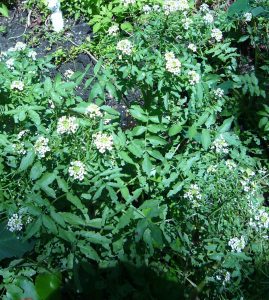
Watercress. Photo by Green Deane
As our cooler months is when we usually see wild members of the Brassica family most of them are nearing the end of their cycle as we warm up. Past season for the most part is Western Tansy Mustard. Wild Mustard and Wild Radish are nearing the end of their bloom and seed cycle. Poor Man’s Peppergrass is here all year but likes the cooler months. The one nice find this past week was Watercress. It’s an import from Europe but found throughout most of North America. Florida once was the winter Watercress growing capital of the United States. Consequently you can find it in nearly any drainage ditch that used to service agricultural land. You can also find in along the banks of local rivers. One thing you have to be very careful about when picking Watercress is not pick any deadly Water Hemlock leaves. They look different but both plants tend to grow in the same area at the same time. I have often seen them intermixed. So when I pick Watercress I examine every steam and leaf at least twice. To read more about Watercress go here.

Green Deane videos are now available on a USB.
150-video USB would be a good spring present and is now $99. My nine-DVD set of 135 videos is being phased out. In fact I do not have any. The USB videos are the same videos I have on You Tube for free. Some people like to have their own copy. The USB videos have to be copied to your computer to play. If you want to order the USB make a $99 “donation” using the link at the bottom of this page or here. That form provides me with your address, the amount — $99 — which tells me it is not a donation. Please include a snail-mail address because they are sometimes not included.

Green Deane Forum
Want to identify a plant? Perhaps you’re looking for a foraging reference? You might have a UFO, an Unidentified Flowering Object, you want identified. On the Green Deane Forum we — including Green Deane and others from around the world — chat about foraging all year. And it’s not just about warm-weather plants or just North American flora. Many nations share common weeds so there’s a lot to talk. There’s also more than weeds. The reference section has information for foraging around the world. There are also articles on food preservation, and forgotten skills from making bows to fermenting food.
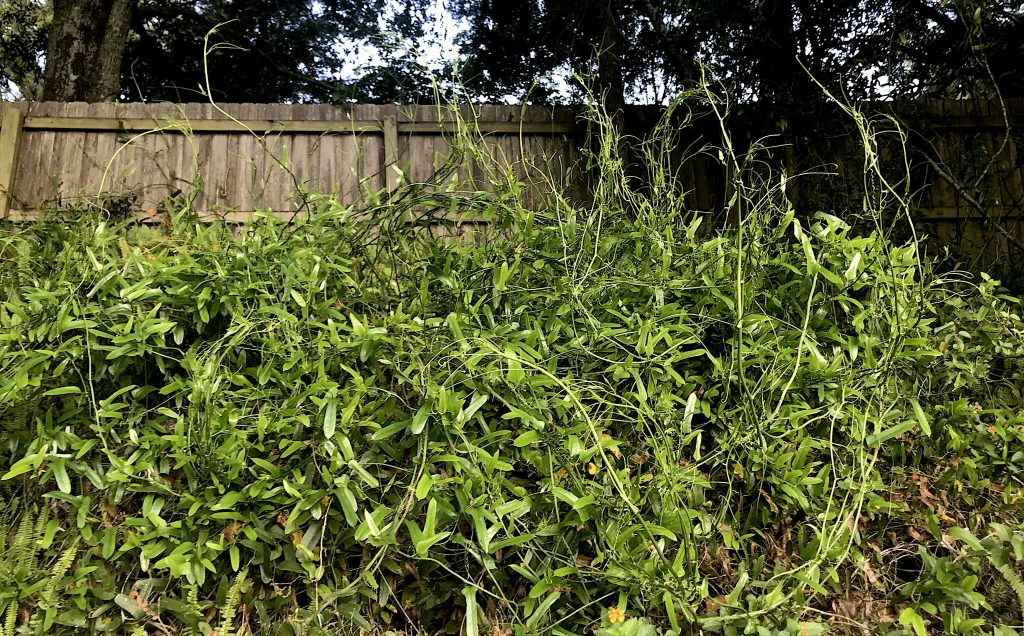
A species to be looking for now is Smilax, which some consider our best spring time green. You can read about it here. See a video here.
This is weekly newsletter #451 If you want to subscribe to this free newsletter you can find the sign-up form in the menu at the top of the page.
To donate to the Green Deane Newsletter click here.

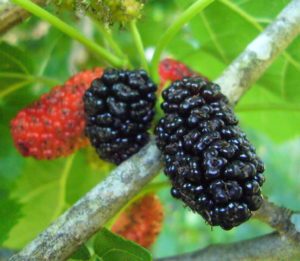

Hi!
There are a ton of places to go in Ocala. The old Fort nature walk and several other parks around the area.
The problem is not places. The problem is the city. They demand I carry the same insurance as a football team and notify them months ahead of time when I want to have a class which they can veto. They have banned all paid foraging classes inside city limits.
Moringa is very easy to grow in Blue Nile soil in Kafouri district of Khartoum North ( Sudan ) . Although its wood is fragile , I personally by sharpening the dry branch could use it as a good handwriting pen by dipping the thin end in black carbon ink . On the other hand , I also could use the wet branch in place of the ” A’arak miswak ” – a kind of Saudi Arabian native tooth brush from A’arak tree . Not to mention the various other uses of Moringa .
I just want to address the fact to the Ocala authorities that in general facilitating matters to a specifically an international forager is benificial to Ocala itself in the first place.
One would think so…
I like to add two uses I personally witnessed
in Moringa’s branch not always mentioned by people: first ;the wet part after removing the leaves can be used in place of the Saudi ” Miswak – a type of natural tooth brush from A’arak tree branch which does’nt need paste . Second ; although the wooden dry part of the branch is fragile as you’ve mentioned , I was able to use it after careful sharpening to make a pen which after dipping in black carbon can give good handwriting as well as making good drawings .